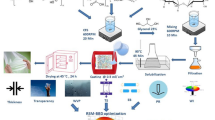Abstract
Polysaccharides from different sources have found their applications in the wound care for their inherent abilities of gelling, biocompatibility, biodegradability, and antibacterial activity. Considering the low cost, ease of processing, abundance in nature and therapeutic benefits of the polysaccharides we developed psyllium, alginate and chitosan (PAC) composite fibers and modelled their physical properties namely; tenacity, linear density and absorption in both distilled water and saline solution; using Box-Behnken (BB) technique of Response Surface Methodology (RSM). The PAC fibers were produced using an in house developed wet spinning module; briefly the dope solutions containing psyllium and alginate were extruded into a hydrolyzed chitosan and CaCl2. The produced fibers were acetone washed to remove the polar solvent; in this case water; and later dried in air. The present work aimed at the development of statistical models for physical properties: linear density, tenacity, antibacterial efficacy and liquid absorption; of the composite PAC fibers. The factors under consideration were the raw material concentration namely; alginate and psyllium in dope solution and calcium chloride (CaCl2) and hydrolysed chitosan in the coagulation bath. The experimental work was designed and analyzed using Minitab® 17 statistical software. Regression models using the under consideration factors were successfully developed.
Similar content being viewed by others
References
T. Ponrasu, P. K. Veerasubramanian, R. Kannan, G. Selvakuar, S. Lonchin, and M. Vignesh, RSC Adv., 8, 2305 (2018).
K. Moore, R. McCallion, R. J. Searle, M. C. Stacey, and K. G. Harding, Int. Wound J., 3, 89 (2006).
K. V. Kavitha, S. Tiwari, V. B. Purandare, S. Khedkar, S. S. Bhosale, and A. G. Unnikrishnan, World J. Diabetes, 5, 546 (2014).
G. D. Winter and J. T. Scales, Nature, 4862, 91 (1963).
R. Masood, T. Husssain, M. Miraftab, A. Ullah, Z. A. Raza, T. Areeb, and M. Umar, J. Ind. Text., 47, 20 (2017).
C. Fernandes, P. C. Acharya, and S. Bhatt, Sci. Rep., 8, 17213 (2018).
Z. Cheng, J. Blackford, Q. Wang, and L. Yu, J. Funct. Foods, 1, 44 (2009).
R. Masood, T. Hussain, M. Miraftab, Z. A. Raza, A. Ullah, T. Areeb, M. Umar, and R. Riaz, J. Wound Care, 27, 394 (2018).
B. S. Patil, V. S. Mastiholimath, and A. R. Kulkarni, Orient Pharma Exp. Med., 11, 123 (2011).
R. Ahmadi, A. Kalbasi-Ashtari, A. Oromiehie, M. S. Yarmand, and F. Jahandideh, J. Food Eng., 109, 745 (2012).
M. H. Fischer, N. Yu, G. R. Gray, J. Ralph, L. Anderson, and J. Marlett, Carbohydr. Res., 339, 2009 (2004).
Q. Guo, S. W. Cui, Q. Wang, H. D. Goff, and A. Smith, Food Hydrocoll., 23, 1542 (2009).
P. Pal, A. Banerjee, K. Soren, P. Chakraborty, J. P. Prakash, G. Sen, and R. Bandopadhyay, J. Polym. Environ., 27, 1178 (2019).
L. Kuen Yong and D. J. Mooney, Prog. Polym. Sci., 37, 106 (2012).
Y. Qin, Polym. Int., 57, 171 (2008).
Y. Qin, H. Hu, and A. Luo, J. Appl. Polym. Sci., 101, 4216 (2006).
K. I. Draget and C. Taylor, Food Hydrocoll., 25, 251 (2011).
S. Thomas, J. Wound Care, 9, 56 (2000).
P. Gacesa, Carbohydr. Polym., 8, 161 (1988).
T. Mikolajczyk and D. Wolowska-czapnik, Fibres Text. East. Eur., 13, 35 (2005).
T. W. Wong, J. Pharm. Pharmacol., 63, 1497 (2011).
A. Niekraszewicz, FIBRES Text. East. Eur., 13, 16 (2005).
Y. Q. Gill, F. Saeed, M. S. Irfan, H. Ehsan, and A. Shakoor, J. Rubber Res., 21, 194 (2018).
R. Masood, T. Hussain, M. Umar, A. Ullah, T. Areeb, and S. Riaz, J. Wound Care, 26, 115 (2017).
I. R. Sweeney, M. Miraftab, and G. Collyer, Carbohydr. Polym., 102, 920 (2014).
L. Fan, L. Yu, Y. Xu, C. Yi, J. Cai, M. Li, and J. Huang, J. Appl. Polym. Sci., 116, 2151 (2010).
T. Hussain, R. Masood, M. Umar, T. Areeb, and A. Ullah, Fiber. Polym., 17, 1749 (2016).
M. Miraftab, J. F. Kennedy, M. R. Groocock, and G. Smart, PCT, WO2004078063 A2 (2004).
B. Simoncic and B. Tomsic, Text. Res. J., 80, 1721 (2010).
W. Steplewski, D. Wawro, A. Niekraszewicz, and D. Ciechanska, Fibres Text. East. Eur., 14, 25 (2006).
C. Knill, J. F. Kennedy, J. Mistry, M. Miraftab, G. Smart, M. R. Groocock, and H. J. Williams, Carbohydr. Polym., 55, 65 (2004).
R. Masood and M. Miraftab, J. Wound Care, 23, 153 (2014).
R. Masood, M. Miraftab, T. Hussain, and V. Edward-jones, J. Ind. Text., 44, 699 (2015).
M. Naseri-Nosar and Z. M. Ziora, Carbohydr. Polym., 189, 379 (2018).
G. D. Mogosanu and A. M. Grumezescu, Int. J. Pharm., 463, 127 (2014).
R. Rathinamoorthy and L. Sasikala, Int. J. Pharm. Pharm. Sci., 3, 38 (2011).
X. L. Yu and Y. He, Sci. Rep., 7, 2789 (2017).
T. Hussain, A. Ullah, M. Umar, T. Areeb, Z. Zubair, R. Masood, and Q. Zia, Color. Technol., 131, 474 (2015).
S. Maity and A. Chatterjee, Fiber. Polym., 14, 1407 (2013).
N. Eslahi, F. Dadashian, and N. H. Nejad, Adv. Powder Technol., 24, 416 (2013).
K. A. B. Vishnu, M. C. Varadaraj, L. R. Gowda, and R. N. Tharanthan, Biochem J., 391, 167 (2005).
Author information
Authors and Affiliations
Corresponding author
Rights and permissions
About this article
Cite this article
Ullah, A., Ullah, S., Areeb, T. et al. An Experimental Study on Modelling the Physical Properties of Composite Psyllium, Alginate and Chitosan Fibers Using Box-Behnken Technique. Fibers Polym 21, 2494–2504 (2020). https://doi.org/10.1007/s12221-020-1277-7
Received:
Revised:
Accepted:
Published:
Issue Date:
DOI: https://doi.org/10.1007/s12221-020-1277-7




